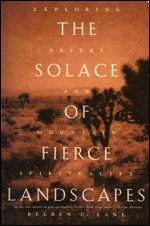![]()
The Solace of Fierce
Landscapes
by Belden Lane
Reviewed by David Denny
Off and on in the ten years since Belden Lane wrote The Solace of Fierce Landscapes, I have sampled it and gleaned gems here and there. But this time around, I gained a profound sense of its power as a whole. How to account for that? As the Greeks put it, the only way to mathos, understanding, is through pathos, suffering. Another way to say it may be that after thirty years in a voluntary desert, I was faced with some involuntary deserts. A big difference.
 Lane tackles three themes in this book:
facing grief over his mother’s final
illness, his instinctive need for solitude
and wilderness during his time of grief,
and the role of wilderness in the history
of Christian spirituality. The beauty in
such an approach is that if you are drawn
to any single theme you will discover its
intimate connection with the other two.
Lane tackles three themes in this book:
facing grief over his mother’s final
illness, his instinctive need for solitude
and wilderness during his time of grief,
and the role of wilderness in the history
of Christian spirituality. The beauty in
such an approach is that if you are drawn
to any single theme you will discover its
intimate connection with the other two.
From Weeping to
Waiting
After the drama of his mother’s bout
with cancer, Lane describes the shift to
a long season of waiting, in which his
mother slips into Alzheimer’s disease.
Instinctively, he heads to the wilderness,
where he finds that the earth simultaneously
ignores and absorbs his grief. And the
desert shares his thirst. As he returns
repeatedly to his mother’s room at
the nursing home, he begins to perceive
it as her monastic cell. Together, he and
his mother move through the traditional
stages of spiritual growth: the purgation
of wrestling with death, loss, grief and
the grotesque human condition; the illumination
that dawns only gradually as they move
through “ordinary time” of
waiting, adjusting to life’s limits,
moving through anguish and anger and unexpected
gifts; the union or profound reconciliation
between the “true story” of
one’s broken life and the truer love
story through which fear, grief, loss and
prayer lead to freedom, laughter, healing
of memory, and service.
A Muddy Baptism
Lane gives memorable accounts of his excursions
to Sinai and Tabor, New Mexico’s
Ghost Ranch, Arkansas’ Upper Moss
Creek, and Christ in the Desert Benedictine
monastery, also in New Mexico. For me,
the most dramatic and memorable is his
account of hiking up a box canyon at Ghost
Ranch. After a mild morning’s hike,
Lane rests on a rock in a stream. Clouds
gather. He scrambles to a small cave in
the canyon wall. “Soon sheets of
water begin to pour over the top of the
canyon rim, loosening the dirt and rocks
high above. Then the sound of falling boulders
echoed through the canyon like shotgun
blasts, crashing right before me onto the
path I’d followed an hour or so before”
(p. 118). After the cloudburst he undergoes
a “baptism” before his return
to the ranch:
Dark red waters flowed down from the side canyon to join the light-tan waters from the upper creek, flowing side by side, then merging together in some great mystery. The new waters entering the creek were a deep, chocolate red, the runoff of multicolored mesas from above. They formed a menstrual flow, these dark waters, as if the land were cleansing itself of its life-giving blood. Viscous and thick, they poured especially heavy from between two large boulders. I climbed over to the place, cupped my hands, and let the waters fall over my head, rolling down my hair and onto my shoulders. (p. 120)
Lane’s personal accounts and lush descriptions, combined with his anguished need to deal with the deaths of his parents, provide an urgent desperation that drives his well-researched exploration of the Christian tradition of apophatic prayer, or wordless, imageless stillness. “This search for the broken Christ in the fields of emptiness,” he confesses, “is what has driven me in this work” (216). Late in the book, I believe him when he claims, “What little expertise I can offer to legitimate these words lies less in the training of a scholar than in the perseverance of the compañero, one who has traveled with another through dangerous territory” (p. 217).